The Cold Chain Packaging Market is a vital component of modern supply chain logistics, ensuring the safe transportation and storage of temperature-sensitive goods. This dynamic industry revolves around innovative packaging solutions designed to maintain the integrity and quality of perishable products, such as pharmaceuticals, food, and beverages.
Advanced materials and technologies, like insulated containers, gel packs, and temperature-monitoring systems, play a crucial role in mitigating temperature fluctuations during transit. With the growing demand for efficient and reliable cold chain systems, the market is witnessing significant expansion. Key players are constantly exploring eco-friendly options and sustainability measures to address environmental concerns while meeting rising global requirements.
Unlock Valuable Knowledge: Get a Report Sample Now: https://www.futuremarketinsights.com/reports/sample/rep-gb-12906
In 2023, it is predicted that the market for cold chain packaging would reach US$ 26.1 billion. It is estimated to continue expanding between 2023 and 2033 at a CAGR of 14.8%. In 2033, the market is projected to be worth more than US$ 103.7 billion.
- The global cold chain packaging market is anticipated to reach US$ 26.1 billion in 2023.
- It is set to expand at a CAGR of 14.8% between 2023 and 2033, reaching US$ 103.7 billion in 2033.
- The top 5 businesses are expected to control 15-20% of the market in 2022, driving sales of cold chain packaging.
- Phase change cold storage products are projected to represent around 55% of all cold chain packaging products by the end of 2023.
- The cold chain packaging industry is estimated to hold 2-3% of the global packaging market worth US$ 980 billion in 2023.
Pharmaceutical products that seem to be temperature sensitive should be safeguarded throughout shipping against rough handling, harsh weather, and other unforeseen circumstances. They need to be maintained with a stable temperature range.
Pharmaceuticals have a complicated supply chain that necessitates attention to numerous small aspects during transit and delivery. Pharmaceutical supplies must be transported to warehouses at specific temperatures.
They must also be properly assembled and sorted before being delivered to the appropriate pharmacies. Adopting cold chain packaging solutions for the transportation of temperature-sensitive goods allows for flexibility in routing and simplicity in handling. It can also reduce the risk of transit-related damage.
Numerous companies are set to launch different types of measures to track vaccine waste at the national level. These initiatives concentrate on the safe handling and delivery of vaccines. Third-party logistics service providers have adopted several cold chain packaging solutions as a result, thereby boosting the market.
The global pharmaceutical sector is expanding quickly as a result of rapid globalization and the development of low-cost medications. Government agencies from all over the world are urging individuals to shift to generic medications and bio-equivalent pharmaceuticals. This is mainly taking place as they are substantially less expensive but still necessitate cold chain packaging and transportation.
Key Takeaways of the Cold Chain Packaging Market
- Insulated containers segment by product type is anticipated to hold more than 1/3rd of the cold chain packaging market share by 2023.
- Reusable packaging formats is projected to exhibit a CAGR of 15.0% between 2023 and 2033.
- The polymer segment by material type is likely to account for around 3/5th of the cold chain packaging market share in 2033.
- By end user, the food segment is estimated to create an incremental opportunity of US$ 17 billion in the forecast period.
- Germany’s cold chain packaging market is likely to surge 3.6 times its present rate in the assessment period.
“Lightweight shippers that provide high volume efficiency tend to offer financial benefits such as low transportation cost due to low shipping weight. To reduce overall cost, manufacturers should select shippers with high payload capacity. Reusable cold chain packaging helps in reducing cost per use and enhances profitability margins for manufacturers,” says a lead analyst at Future Market Insights.
Efficient Pallet Shippers to Become an Ideal Choice for Manufacturers to Fulfil Ultra Low-Temperature Requirements
Numerous pharmaceutical treatments designed to treat uncommon diseases frequently contain valuable components with a limited shelf life. They also contain severe temperature specifications such as a temperature range of -40 to -150 degrees Celsius. Demand for pallet shippers that provide safe delivery of such materials is hence anticipated to increase as the use of medicinal products with ultra-low temperature ranges increases.
Businesses can take advantage of this opportunity to the fullest by creating packaging options tailored to this product category and gain a sizable competitive edge. Pallet shippers are traditional heavy duty metal boxes that are actively handled and have substantial transportation issues for lengthy multi-modal routes.
They are utilized for air freight shipping. Nevertheless, numerous businesses have recently released passive pallet shippers that make use of high-density polyurethane insulation technology.
For bulk shipments, this results in convenience, dependability, and value. Key cold chain packaging solution providers have a great chance in this market to produce effective passive pallet shippers as active competitors are expensive and insufficient for remote transportation needs.
Growing Food and Beverages Industry Spurring Growth
Cold chain packaging solutions are widely used in the food and beverages industry as they provide with the proper refrigeration during the transport and distribution of the food and beverages while preserving the quality.
During the height of the COVID-19 pandemic, as other industries witnessed waning demand, the food and beverage industry continued to post gains in many countries. Further, as supply chains relied on e-commerce, demand for efficient storage and packaging grew manifold.
Considering the change in status-quo brought about by the COVID-19 pandemic, it is likely that demand for cold chain packaging will continue to grow through 2020-2030.
Request Report Methodology: https://www.futuremarketinsights.com/request-report-methodology/rep-gb-12906
Key Segments Covered In Cold Chain Packaging Industry Research
Product Type :
- Pallet Shippers
- Insulated Containers
- Foam Bricks
- Gel Packs
- Protective Packaging
- Phase Change Cold Storage Products
Material Type :
- Polymer
- Polyethylene
- Polypropylene
- PET
- EPS
- Polyurethane
- Others
- Metal
- Paper
Packaging Formats :
- Reusable Packaging
- Disposable Packaging
End-use :
- Food
- Meat, Poultry & Seafood
- Dairy Products
- Fresh Produce
- Bakery & Confectionary
- Beverages
- Alcoholic Beverages
- Non-Alcoholic Beverages
- Pharmaceutical
- Cosmetics & Personal Care
- Chemical
- Others
Author:
Ismail Sutaria (Lead Consultant, Packaging and Materials) has over 8 years of experience in market research and consulting in the packaging & materials industry. Ismail’s strength lies in identifying key challenges faced by the client and offering logical and actionable insights to equip the clients with strategic decision-making power.
Ismail has been an instrumental part of several transformational consulting assignments. His key skills include competitive benchmarking, opportunity assessment, macroeconomic analysis, and business transformation advisory. Ismail is an MBA holder in Marketing and has a Bachelor’s Degree in Mathematics.
Ismail is a regular at industry conferences and expos and has been widely covered in electronic and print media. He is a Speaker at our upcoming Talk show – Rise of the Intelligent Packaging. Ismail has been quoted in leading publications, including the European Pharmaceutical Review and the European Adhesive Tape Association.
About Future Market Insights (FMI)
Future Market Insights, Inc. (ESOMAR certified, recipient of the Stevie Award, and a member of the Greater New York Chamber of Commerce) offers profound insights into the driving factors that are boosting demand in the market. FMI stands as the leading global provider of market intelligence, advisory services, consulting, and events for the Packaging, Food and Beverage, Consumer Technology, Healthcare, Industrial, and Chemicals markets. With a vast team of over 5000 analysts worldwide, FMI provides global, regional, and local expertise on diverse domains and industry trends across more than 110 countries.
Contact Us:
Future Market Insights Inc.
Christiana Corporate, 200 Continental Drive,
Suite 401, Newark, Delaware – 19713, USA
T: +1-845-579-5705
For Sales Enquiries: sales@futuremarketinsights.com
Website: https://www.futuremarketinsights.com
LinkedIn| Twitter| Blogs | YouTube





